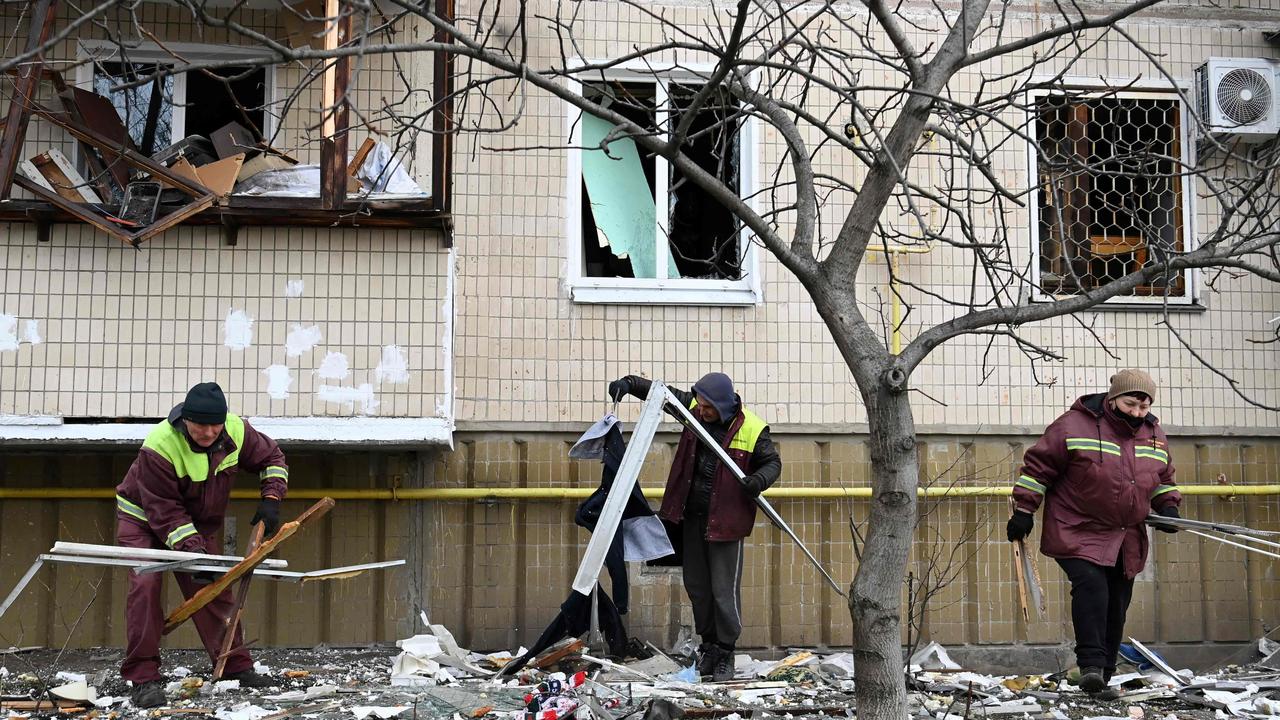Signs things are not going to plan for Putin as Ukraine fights back against invasion
Russia’s invasion of Ukraine has been bloody and brutal – but military analysts have noticed things aren’t entirely going to plan.
Ukraine hangs in the balance.
Russian forces are fighting in the capital Kyiv. It controls the skies. Its forces have pushed deep into the beleaguered country.
But there are signs Russian President Vladimir Putin’s “thunder-run” may be on the brink of stumbling.
Ukranian President Volodymyr Zelensky was blunt in his Saturday address.
“This night will be harder than the day. Many cities of our state are under attack: Chernihiv, Sumy, Kharkiv, our boys and girls in the Donbas, the cities of the south, special attention to Kyiv. We can’t lose the capital.”
He was right.
And his people held.
Disguised Russian soldiers have been attempting to infiltrate the city. Armoured vehicles are battling around its edges. Missiles and aircraft have been relentlessly battering key positions.
But military analysts have noticed things aren’t entirely going to plan.
NEW MAP AND REPORT: Russian forces entered major Ukrainian cities — including #Kyiv and #Kherson — for the first time on February 25. Read the full report: https://t.co/djGQiIdAJhpic.twitter.com/hwR4nuEzCB
— ISW (@TheStudyofWar) February 25, 2022
“I think there is something very interesting happening,” says Kings College London War Studies fellow Dr Mike Martin.
“It seems that the Russians are a bit surprised that the Ukrainians have fought back. And fought back well.”
Important Ukrainian border cities are still holding out. Moscow appears to control minimal land. Large pockets of resistance are fiercely repulsing advances. And the tally of social media videos and photos showing burnt-out Russian vehicles is soaring.
“Putin basically assumed that the Ukrainians would collapse, so all they would have to do is a thunder run to Kyiv,” says Dr Martin.
“Don’t worry about the logistics – we’ll sort that out once we’ve toppled their government.”
It’s a huge gamble. And the dice may be turning against him.

Fascinating. Makes sense to me. https://t.co/Cdwq4e6yNc
— Richard Moore (@ChiefMI6) February 25, 2022
The day after Zelensky’s appeal was very different.
“We are striking the enemy around Kyiv. The enemy is not moving for now”, a Ukrainian government spokesman said this morning.
But it’s not over yet.
British MI6 intelligence agency chief Richard Moore has gone public, adding his weight to an assessment that predicts Ukraine will have to stand fast for another week before Russia’s military exhausts itself.
Amateurs talk tactics; professionals talk logistics
President Putin’s attack plan is well understood. It’s an evolution of older Soviet Union-era armoured warfare ideas.
It’s called a “deep strike” doctrine. It involves fast-moving columns of armoured vehicles moving quickly to circle opposing forces. It relies on heavy artillery support to weaken opponents in its path. It needs a constant stream of troops and supplies to keep moving and suppress any resistance.
It’s supposed to seize bridges and secure airports. It’s all about supply lines.
“The key to this is moving fast. And keeping your logistics protected – your armour is going to be out on a limb,” Dr Martin writes.

Exactly how this tactic is panning out remains to be seen.
But it is a plan Ukraine was expecting. After all, its armed forces were also part of the former Soviet Union. They also were trained in the same methods. They understand its weaknesses.
And President Putin, who has long since surrounded himself with staff who put loyalty above competence, may have believed his own propaganda.
This is the location the video was taken at and the estimated angle of the photographer at the first frame of the video. Cords: 51.776691, 30.248421 https://t.co/HwQxBdDufspic.twitter.com/dov6uyZLSL
— Guy Agam Fusfus (@gfusfus) February 25, 2022
“If you’re the Ukrainians and you know that the Russians are gonna use some variant of deep strike doctrine, what do you do? You let the armoured columns pass and then destroy the log tail using stay behind parties armed with antitank weapons, or using helicopters, whilst keeping them out of the cities,” Dr Martin explains.
They may be having some effect.
Ukrainian authorities are reporting a new airbourne assult by Russian forces in Zhtomyr region, about 200km away from Kyiv. Potentially a second attempt to establish an aerial bridge-head following the reported repelling of a similar attempt at Hostomel yesterday. https://t.co/CjRKfaCGtLpic.twitter.com/Y6WsWqOZmk
— Nathan Ruser (@Nrg8000) February 25, 2022
“The Russians are taking casualties, which it seems they weren’t expecting,” says Dr Martin. “The Russian ministry of health had just effectively mobilised civilian doctors in Russia. One assumes to deal with the level of casualties being sustained.”
Among the social media posts made by Ukraine’s citizens are scenes of captured and burnt-out trucks. While wrecked armoured personnel carriers and tanks get most of the attention, it’s their support vehicles that tell an important tale.

“Amateurs talk tactics and professionals talk logistics,” says Dr Martin.
“I would guess that a lot of the Russian casualties are the logistic elements that are following up.”
Satellite imagery reveals more than 90 #Russia 🇷🇺 attack and transport helicopters deployed along a 5 mile stretch of #Belarus 🇧🇾 highway this afternoon some 20 miles for #Ukraine 🇺🇦 border
— Joseph Dempsey (@JosephHDempsey) February 25, 2022
📷: @Maxarpic.twitter.com/6l5tYp7X7z
But the war has only just begun.
“So far, the Russians seem to have committed about 50k forces or a third of what they have. So maybe there are more echelons coming, and maybe the Russians will still overwhelm Kyiv. Or maybe they won’t. It seems in the balance,” Dr Martin writes.
“And the longer the Ukrainians can hold on, the less the Russians will be able to continue.”




